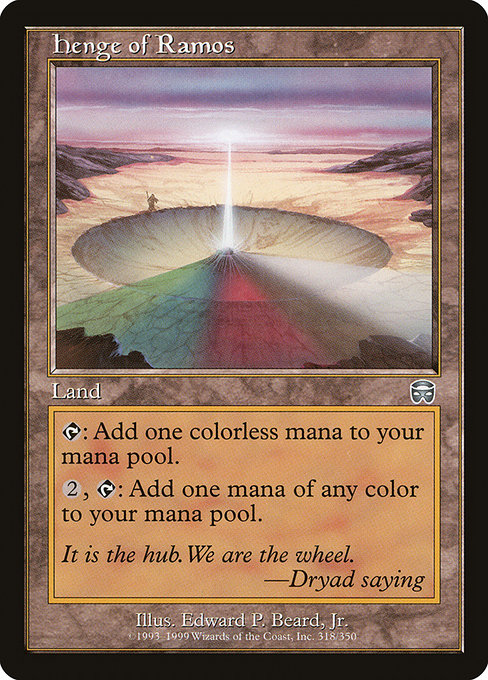
Image courtesy of Scryfall.com
Interplay of Randomness and Skill in Mercadian Masques Land Strategies
Magic thrives on a delicate balance between luck and expertise. The randomness of what you draw can feel like a landslide, but skilled players bend that luck to their will through careful deck design, timing, and mana management. When you peek at a land like Henge of Ramos, you glimpse a microcosm of that balance: a 0-mana, colorless entry point that doubles as a flexible engine for hard-casual, multi-color ambitions. It’s not a flashy spell; it’s a quiet, resilient Swiss Army knife that rewards smart usage and cool-headed planning. 🧙🔥💎
Card snapshot — a quick look under the hood of this Mercadian Masques gem helps frame the discussion:
- Card type: Land
- Mana cost: 0
- Text: T is for colorless mana; 2, T adds one mana of any color
- Produced mana: {B}, {C}, {G}, {R}, {U}, or {W} — any color
- Set: Mercadian Masques (MMQ), 1999
- Rarity: Uncommon
- Flavor text: “It is the hub. We are the wheel.” — Dryad saying
- Artist: Edward P. Beard, Jr.
- Legalities: Legacy, Vintage, Commander, Duel, Premodern, and more — not Standard
What makes Henge of Ramos particularly instructive is its two-step mana flexibility. The land opens with a pure colorless option, a dependable first tap that helps stabilize early turns where you might be light on colored sources. Then, for a cost of two mana plus a tap, it becomes a bridge to any color you need. In practice, this is a potent antidote to mana-screw in multi-color builds. You’re paying a small tax in tempo and resource planning, but the payoff is the ability to cast a critical threat or answer a problem spell even when your mana base isn’t perfectly tuned. ⚔️🎨
It is the hub. We are the wheel.
The interplay between randomness and skill here is a matter of risk management. A deck with only two or three colors is slightly less dramatic, but a true commander or vintage brew that wades into five-color territory can lean on Henge of Ramos as a rock in the river: it doesn’t fix every leak, but it guarantees a path to color when you need it. In this sense, the card nudges players toward better decisions about land count, color distribution, and draw sequencing. It shifts mana issues from a binary problem (can I cast this now?) to a spectrum (which two colors do I need most right now, and how can I set up the next few turns to deliver them?). 🧙♂️💎
Format-savvy strategy: where this land shines
Mercadian Masques marked a transitional era in MTG design, with a focus on land and mana stability that could survive under the weight of modern multicolor ambitions. In Legacy and Commander environments, Henge of Ramos can be a quiet workhorse. It’s not a killer bomb that ends the game, but it can be the strategic backbone that unlocks your big plays by providing reliable color access when you need it most. It’s not legal in Standard, which reinforces the sense that this is a card built for enduring formats where players can lean on deeper mana infrastructure and more resilient color pipelines. 🧭
In deck-building terms, think of Henge of Ramos as a flex land that pairs well with fetch-like acceleration and mana-rich engines from earlier eras. In a multi-color shell, you value its ability to pay two mana and a tap to fetch a color you’re lacking for that crucial curve-topping spell. It’s a subtle but meaningful contributor to your mana-smoothing plan, reducing the variance of color availability without requiring you to over-commit to specific fetches or shock land tricks that might strain your curve. The net effect is a more predictable draw sequence, which is the essence of turning randomness into skillful play. 🎲🧙♀️
From a lore and art perspective, the card’s flavor text anchors its identity as a central connector in the mana-ecology of the world. The Dryad’s proclamation hints at a wheel-and-hub metaphor for balance in a game where tempo, resource management, and color identity all revolve around the same core principle: knowing when to tap, when to wait, and how to pivot your color plan on the fly. The artwork, by Edward P. Beard, Jr., evokes the era’s tactile fantasy—lush, organic imagery meeting the mechanical pragmatism of a card that simply asks you to think a step ahead. 🎨✨
As for collectability, Henge of Ramos sits in the uncommon slot with a modest baseline price in non-foil form and a noticeably higher foil value. Its enduring utility across Legacy, Vintage, and Commander formats keeps it relevant in casual and tournament contexts alike, while the MMQ era’s nostalgia adds that extra layer of charm for collectors who love the lineage of land design from a pre-2000s MTG landscape. Price awareness matters here: a common foil spike might occur when players discover new commander builds that lean on color flexibility, and that’s part of the card’s living history in the market. 💎🧩
For fans who enjoy a tactile desk companion while pondering color choices and combat math, a well-chosen desk accessory can complement the MTG vibe. Speaking of stylish desk gear, a Neon Phone Stand can keep your device handy during long sessions or draft nights—sleek, colorful, and perfectly at home beside your mana curve. If you’re curious, you can explore this chic piece and other desk decor options here. Linking the worlds of play and display helps keep the mythos alive in your everyday space. 🎲🧙♂️